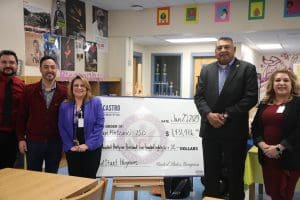
Congressman Castro visits South San Antonio ISD
U.S. Congressman Joaquin Castro visited South San Antonio ISD as he came to tour our Pre-K/Headstart Program. South San Antonio ISD was recently awarded $1,431,486.00

* Campaign (Go Public)

Find Texas Schools and Independent School Districts
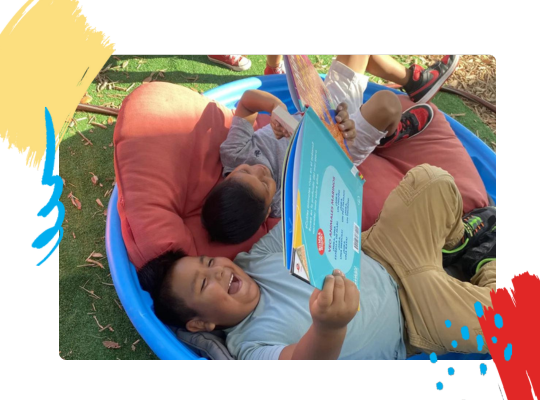
Pre-K students at East Central ISD's Salado Elementary engage with the outdoor workspaces.
Two years prior to starting kindergarten is typically the age most children start preschool. Preschool programs, also known as PreK or Pre-K, often set an enrollment minimum age of 3 years old. Parents and caregivers can spend a great deal of time researching if preschool is right for their child. Preschool can be seen as a way to jumpstart into kindergarten. Additionally, the benefits of Pre-K are compelling.
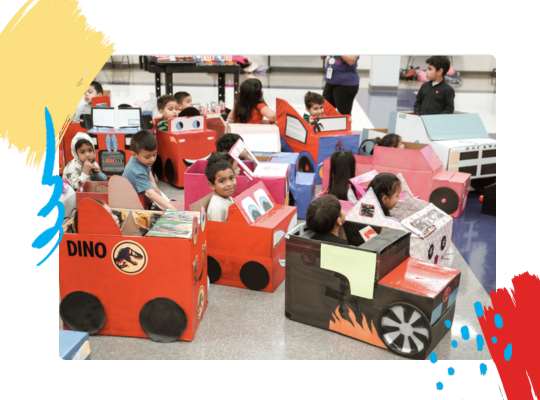
Angleton ISD's Pre-K students created a box car of their own and enjoyed a drive-in movie.
Traditional public school districts adhere to state guidelines and standards for all schoolchildren. Pre k curriculum and teaching strategies are developed and provided by educators and degreed child development experts. PreK curriculum is reviewed and assessed by the state’s education agency or education department. The pre-k curriculum must meet state standards set by the board of education.
Effective preschool classrooms are places where children feel well-cared-for and safe. They are places where children are valued as individuals and where their needs for attention, approval, and affection are supported. They are also places where children can acquire a strong foundation in the knowledge and skills needed for future school success.
Effective preschool teachers and child care providers:
The main difference between preschool and pre-k is the age of the children enrolled. Preschool tends to refer to children ages 2-3, and Pre-k is for older children ages 3-5.
Preschool and pre-kindergarten curriculums are very similar. They both promote learning using the technique of play. Play learning means that children participate in developmental hands-on activities that nurture their creativity, problem-solving skills, teamwork, communication skills, and more. Children learn introductions to math, art, science, and music through play.
Montessori schools aim to provide an environment of hands-on learning, while children are encouraged to focus on activities that they are most interested in.
Students who master certain skills may go ahead of traditional grade-level expectations, and those who aren’t yet prepared to move on can take more time. It is the student’s choice. (US News)
The largest Pre K program in America is part of the Head Start program, which is administered by the Office of Head Start within the U.S. Department of Health and Human Services. The Office of Head Start grants funding and oversees the agencies that provide Head Start services, as well as training and technical assistance.
Head Start programs prepare preschool children for success in school by serving low-income families in order to help close the socio-economic divide. The program was designed to meet the emotional, nutritional, and social needs of disadvantaged children in a positive learning environment.
Early Head Start serves children ages birth to 5 years old, while Head Start enrollment ages are between 3 and 4 years old. Children who are 3 years old prior to September 1 are eligible to apply for Head Start. Families applying for Head Start services must meet poverty guidelines, and those receiving public assistance such as TANF are automatically eligible. Early Head Start programs are available to the family until the child turns 3 years old and is ready to transition into Head Start or another pre-K program.
These programs offer a variety of resources and support, depending on the needs of their communities. The programs cater to the cultural and ethnic heritage of each local Head Start family. Some of the highlights and benefits of these programs include:
Children in Head Start receive nutritious meals and health and development screenings. Families are connected with medical, dental, and mental health support. Children are allowed to explore and thrive in their environment in order to develop physical and motor skills.
Students receive nutritious meals and health and development screenings. Families are connected with medical, dental, and mental health support. Children are allowed to explore and thrive in their environment in order to develop physical and motor skills.
Head Start families engage in their child’s learning, therefore the parent-child relationship strengthens. The program helps parents achieve financial, housing, and educational goals with community support and guidance.
Listening- Follow two or three step directions during activities such as setting the table, playing, or cleaning up. Have short conversations. Listen to stories and directions from adults. Play with friends.
Reading -Name familiar characters or events from books. Guess what happens next in a story. Participate in story time and choose their own books.
Writing- Make scribbles, line marks, and letter-like forms when asked to write. Use a variety of writing and drawing materials such as different types of pens, crayons, markers, or paintbrushes. Play with letter blocks, magnets, and other reading materials.
Speaking- Ask questions and wait for answers. Use many words when speaking about feelings, places, people, or things. Have conversations with friends and adults.
Describing- Talk about plants and animals and what they look or feel like. Talk about the weather. Go on nature walks. Play outside. Read books about plants, animals, weather, and seasons. Play with and talk about toy cars that go different speeds, balls that bounce at different heights, or bubble wands.
Counting- Count up to 10. Read books, sing songs, and play games that include counting. Play with a variety of objects that can be counted such as blocks or shapes.
Identifing Shapes- Name and create common shapes. Play with blocks of different shapes and sizes. Play with materials to make shapes such as play dough.
Fine Motor Skills – Squeeze small objects between thumb and forefinger. Draw shapes and write some letters and numbers. Dress and undress with little help. Play with clay and play dough. Use tools such as tongs, clothespins, or safety scissors. Write and draw with a variety of pens, markers, pencils, and crayons. Make art with materials of different textures.
Gross Motor Skills- Hop, skip, jump, and gallop. Climb jungle gyms. Ride a tricycle. Play games with a variety of movements. Play outside.
Emotions- Talk about emotions and feelings. Read books about emotions. Use puppets to role play emotions. Name characters’ feelings in books.
Health & Hygiene- Wash hands after using the toilet and before eating. Name body parts. Sing songs and play games that identify body parts such as Follow the Leader or Head, Shoulders, Knees and Toes. Read books about washing hands, getting ready for school, or bed time.
Relationships with Others- Enjoy playing and talking with adults and friends. Learning Strategies: Play games in small or large groups. Read books about playing with friends.
https://tea.texas.gov/academics/early-childhood-education/prek3familyguideb.pdf
Listening- Follow two or three step directions during activities such as setting the table, playing games, or cleaning up. Have conversations with expected words and responses. Play games with multiple steps. Play in large and small groups. Listen to stories and directions.
Writing- Use marks or letters to write Use writing materials in multiple areas of the classroom, such as creating signs in block play or grocery lists in the pretend play center. Write in a journal and make books or drawings with words.
Speaking- Ask and respond to questions. Use many words when speaking about feelings, people, places, or things. Have conversations with friends and teachers. Play games with friends. Read books out loud
Reading- Enjoy being read to and exploring books. Name rhyming words. Play games with multiple steps. Play in large and small groups. Listen to stories and directions.
Describing- Talk about the color, size, shape, and feel of plants, animals, and earth materials such as rocks, soil, or sand. Go on nature walks. Play outside. Grow plants and discuss their progress. Read books about plants, animals, weather, and seasons.
Counting- Count from 1-30. Count 1-10 objects, with one count per object. Sing songs or play games that include counting. Play with a variety of objects that can be counted such as blocks or shapes.
Identifying Shapes- Name and create shapes. Play with blocks of different shapes and sizes. Play with materials such as play dough and toothpicks to make shapes.
Comparing Objects Place objects from shortest to tallest or tallest to shortest. Use measurement words such as “taller”, “shorter”, “longer” or “smaller”. Play with objects that can be sorted and arranged such as blocks or figures. Play with and talk about toy cars that go different speeds, balls that bounce at different heights, or bubble wands that create different sized bubbles. Guess the length, height, or volume or objects such as buckets, fish tanks, or furniture.
Fine Motor Skills- Use tools such as forks, spoons, tweezers, clothespins, or paintbrushes with ease. Dress and undress without help. Draw shapes and write letters and numbers. Play with clay or play dough. Write and draw with different types of writing and art materials such as pens, pencils, paint brushes or crayons. Make art by tearing paper, using cookie cutters, or stringing beads.
Gross Motor Skills- Stand on one foot. Hop, skip, jog, jump, and gallop. Carry a bowl or plate of food from one spot to another. Play games with many movements. Help with meal times. Play outside.
Health & Hygiene- Wash hands after using the toilet and before eating. Name body parts. Sing songs and play games that identify body parts such as Follow the Leader or Head, Shoulders, Knees and Toes. Read books about washing hands, getting ready for school, or bed time routines.
Relationships with Others- Enjoy playing with friends and adults. Initiate play and conversations. Have conversations with adults and friends. Play with friends. Read books about playing with friends, taking turns, or helping others. Have a classroom job such as a greeter, door holder, or line leader.
Emotions & Behavior- Talk about and name emotions and feelings. Follow classroom rules and routines with help and reminders from the teacher. Read books about emotions. Use puppets to role play emotions. Name characters’ feelings in books.
https://tea.texas.gov/sites/default/files/PreK_4_Family_Guide.pdf
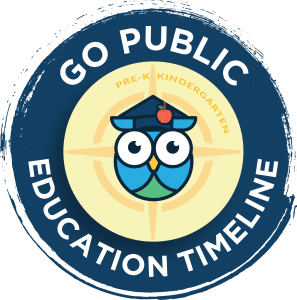
Go Public’s Education Timeline helps parents learn what to expect for early education, Pre-K, and kindergarten.
Public school Pre-k programs help prepare children for a smooth transition to elementary school.
In Angleton ISD’s Westside Elementary school, small-group learning pairs students with similar abilities. The program pushes a higher-performing group further along and encourages deeper learning, like reading a higher-level book. A group that may be struggling with a certain lesson works with teachers individually instead of learning as a whole class. The learning strategies allow one-on-one attention for students and give a better, more effective learning environment for every level of learning.
Alief ISD’s innovative interactive pre-k program offers an exciting classroom environment where kids can fully engage with the materials in the room, the graphics on the walls, and different programs around the room. The program r gives special opportunities for kids to learn through hands-on experiences and interactive activities from program to program. Students learn through play as they complete activities together, socialize, and grow with one another.

U.S. Congressman Joaquin Castro visited South San Antonio ISD as he came to tour our Pre-K/Headstart Program. South San Antonio ISD was recently awarded $1,431,486.00
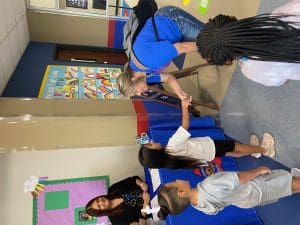
Royal ISD district and campus leaders were treated to a tour of the Royal Early Childhood Center. The group was greeted by ECC Ambassadors followed
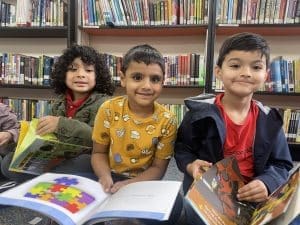
Fort Bend ISD’s prekindergarten students and their families received a generous book donation from a new statewide program that encourages reading at an early age.
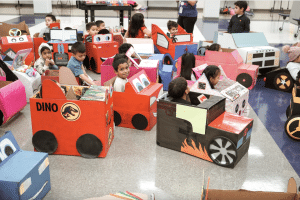
Overload of cuteness as Angleton ISD pre-k kiddos create cars out of cardboard boxes! At Angleton’s Central Elementary School, pre-k students have been learning all

Early Childhood Reading: What Public School Districts Do for You As a child grows, they are constantly learning; learning to eat, learning to walk, learning
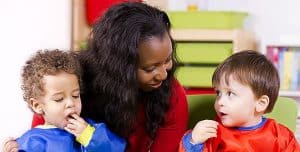
Understanding the Choices and Guidelines for Finding a PreK My kids are in elementary and high school, and it seems like a lifetime ago when
© Copyright 2023 – We Go Public – All Rights Reserved

If you want to take advantage of this benefit or learn more about how a membership can help your organization please click the button below.